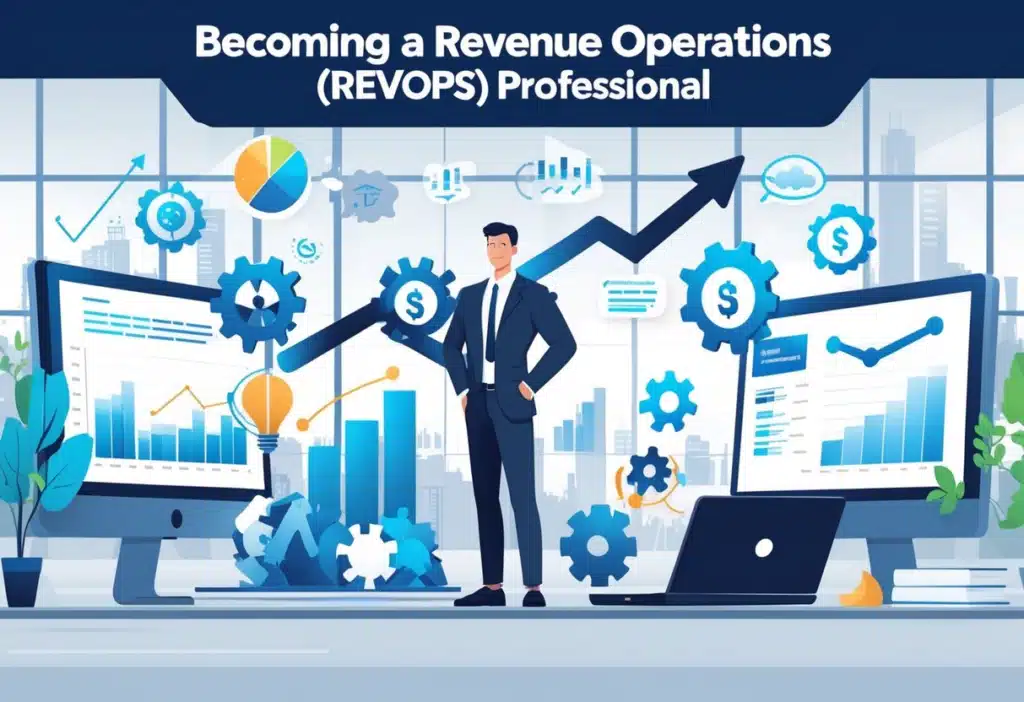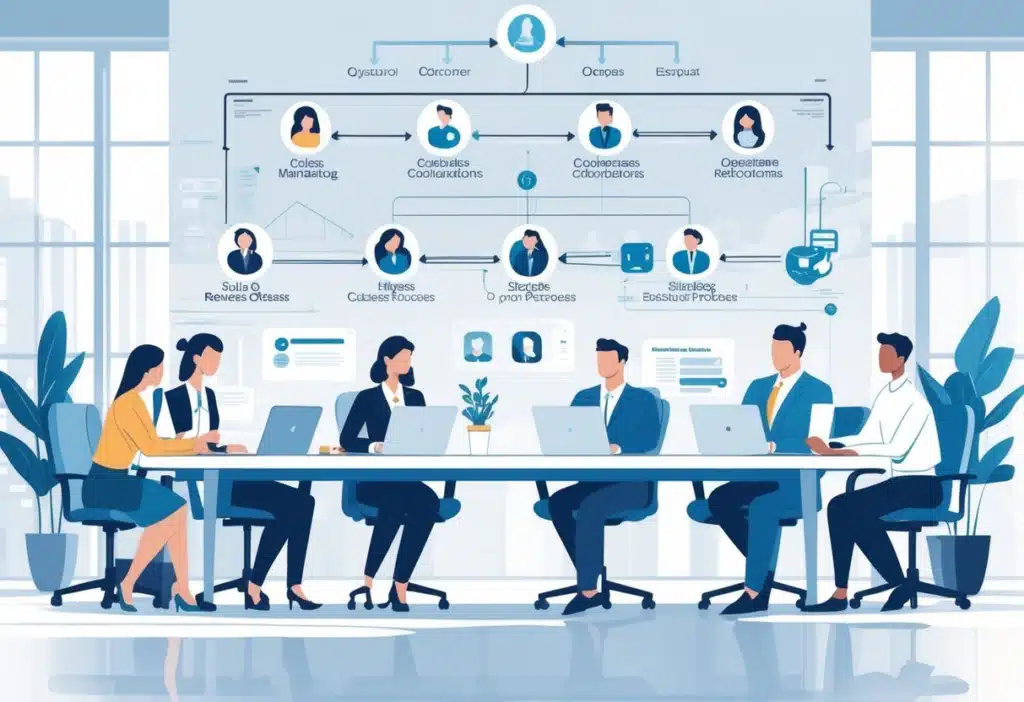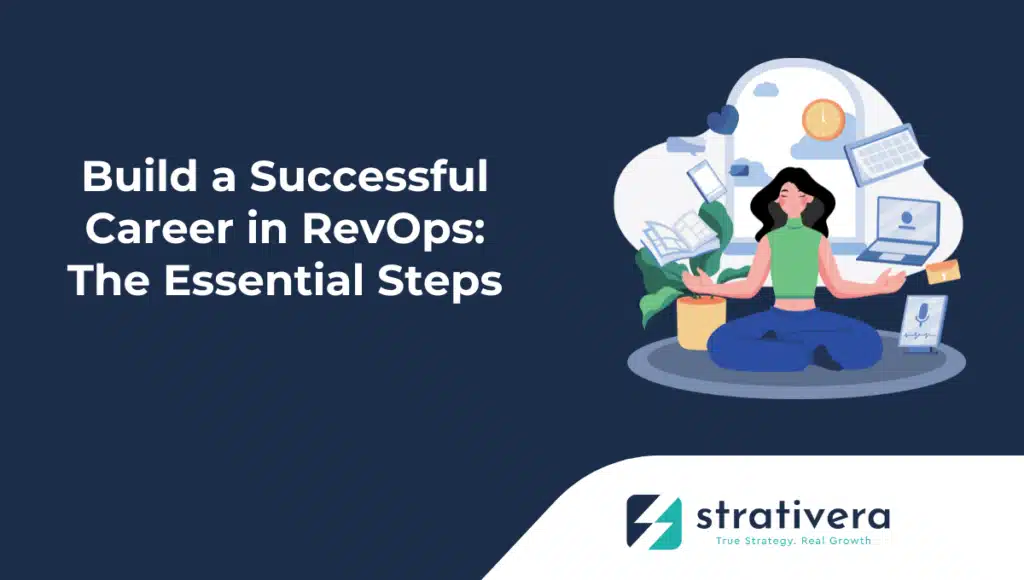Table of Contents
Revenue Operations is one of the hottest career fields around right now. LinkedIn even points to its huge growth potential over the next decade.
This discipline bridges sales, marketing, and customer success teams. The goal? Optimize revenue with smart processes and tech that actually work.

If you want to break into RevOps, you’ll need a mix of technical chops, analytical instincts, and solid business sense. Experience with CRM platforms, analytics tools, and revenue optimization strategies makes a big difference.
People come into RevOps from all sorts of backgrounds—sales ops, marketing ops, business analysis, or CRM consulting roles are all good starting points.
To get started in RevOps, you’ll want to build core skills in process optimization, tech implementation, and cross-functional teamwork. Understanding team structures, mastering essential tools, and sometimes earning a few certifications can help you move up in this fast-changing field.
Understanding Revenue Operations

Revenue Operations brings sales, marketing, and customer success together under one roof. This is a big change from the old-school sales ops approach—it covers the entire customer lifecycle and all go-to-market functions.
Definition of RevOps
Revenue Operations (RevOps) is a strategic framework that unites all revenue activities in a company. It puts marketing, sales, customer success, and finance on the same team to help the business grow.
RevOps gets everyone working toward shared goals. Teams use consistent processes and tech to boost efficiency. This strategy ties together processes, tools, and data across the customer journey.
RevOps breaks down silos between departments. It sets unified goals and helps companies become revenue powerhouses. The people in these roles manage the intersection of people, processes, and tech.
Core Principles of Revenue Operations
Alignment really matters in RevOps. All go-to-market teams work toward the same objectives and use common metrics to measure success.
Data-driven decisions guide RevOps strategy. Teams rely on unified data and consistent reporting, so conflicting info doesn’t slow things down.
Process optimization keeps workflows running smoothly. RevOps finds bottlenecks that hurt revenue growth and rolls out standardized processes to improve customer experience.
Technology integration is another big one. RevOps connects marketing automation, CRM, and customer success tools so data flows easily. This gives everyone a full view of revenue performance.
Continuous improvement keeps teams sharp. RevOps pros look at performance metrics and tweak things as the market or business needs change.
Key Differences Between Revenue Operations and Sales Operations
Sales operations sticks to sales teams and their processes. It handles CRM, sales enablement, and sales metrics—mostly after leads come in.
Revenue operations covers everything: marketing, sales, customer success, and the whole customer lifecycle—from first touch to renewal and expansion. RevOps looks at the big picture.
Scope Comparison:
| Sales Operations | Revenue Operations |
|---|---|
| Sales team focused | Cross-functional alignment |
| Post-lead activities | Full customer lifecycle |
| CRM and sales tools | Integrated tech stack |
| Sales metrics only | End-to-end revenue metrics |
RevOps pros work with more stakeholders and handle complex integrations. They chase customer lifetime value, not just closing deals. This takes a different mindset than traditional sales ops roles.
RevOps Roles and Team Structures

RevOps folks work in a bunch of roles that link sales, marketing, and customer success. Team structure depends a lot on company size—startups want generalists, while bigger companies go for specialists.
Common RevOps Job Titles
Entry-level jobs include RevOps Analyst and Operations Coordinator. These folks crunch data, make reports, and document processes across revenue teams.
Mid-level roles—think Revenue Operations Manager or Sales Operations Manager—usually need 3-5 years’ experience. They manage specific areas and coordinate cross-functional projects.
At the top, you’ll find Director of Revenue Operations and VP of Revenue Operations. They build strategy and lead teams of specialists.
Specialized roles are popping up as companies grow. Customer Success Operations managers focus on retention and expansion. Marketing Operations pros handle campaign attribution, lead scoring, and managing marketing tech.
Some companies mix things up with hybrid jobs like Business Operations Manager or Go-to-Market Operations Analyst. These blend RevOps tasks with broader business strategy work.
RevOps Team Structure and Collaboration
Company size shapes RevOps structure more than anything else. Small businesses usually have operations managers juggling RevOps alongside other roles.
Mid-sized companies often build a centralized RevOps team. One leader oversees specialists in sales ops, marketing ops, and customer success ops.
In big enterprises, RevOps spreads out across departments. Each team has its own ops crew, but a central RevOps group coordinates strategy and standards.
Collaboration looks different everywhere, but weekly cross-functional meetings are common. RevOps folks act as go-betweens for sales, marketing, and customer success to keep everyone aligned.
Matrix reporting happens a lot in bigger companies. For example, a marketing ops specialist might answer to both the CMO and the Director of Revenue Operations.
Key Responsibilities Across Functions
Sales ops handles territory planning, quotas, and sales process optimization. They manage CRM systems, build dashboards, and keep an eye on pipeline health.
Marketing ops takes care of campaign management, lead routing, and attribution modeling. They run marketing automation platforms and make sure leads get handed off to sales smoothly.
Customer success ops looks after onboarding, renewals, and expansion. They design customer health scores and manage integrations with success platforms.
Cross-functional duties include data governance, tech stack management, and performance reporting. RevOps teams set the standards for key metrics like qualified leads and closed-won deals.
They also handle process documentation and training. Team members write standard operating procedures and run training sessions for revenue teams.
Revenue forecasting and planning are big collaborative efforts. RevOps teams work with leadership to build accurate projections and capacity models for all revenue functions.
Essential Skills and Qualifications for RevOps Professionals
To thrive in RevOps, you’ll need technical skills, people skills, and a knack for strategy. These help you bridge sales, marketing, and customer success—and actually make a difference to the business.
Technical and Analytical Skills
Data analysis is the backbone of RevOps. You’ll want to get comfortable with Excel, SQL, and BI tools like Tableau or Power BI to pull insights from messy datasets.
CRM management is also huge. Knowing Salesforce administration—like workflow automation, custom fields, and report building—will get you far.
Core skills for RevOps include analytics, process design, and data stewardship. You’ll also need hands-on experience with marketing automation platforms like HubSpot, Marketo, or Pardot for lead scoring and campaign work.
Key technical skills:
- Advanced Excel and Google Sheets
- SQL for database queries
- CRM admin (Salesforce, HubSpot)
- Marketing automation tools
- Business intelligence platforms
- API integrations and data mapping
Revenue forecasting and metrics tracking call for sharp analytical thinking. You’ll need to spot trends, build predictive models, and turn numbers into recommendations for leadership.
Cross-Functional Communication
RevOps pros act as translators between technical teams and business leaders. You’ll have to explain complex data in plain English so sales reps and execs can actually use it.
Stakeholder management means building relationships across departments. You’ll spend time talking with sales managers, marketing directors, and customer success leaders to keep everyone on the same page.
Presenting is a big part of the job too. You’ll share business reviews, process updates, and strategic ideas with senior leadership and sometimes board members.
Communication skills you’ll need:
- Presenting to executives
- Collaborating across departments
- Documenting processes and training others
- Facilitating change management
- Resolving team conflicts
Training and enablement come with the territory. RevOps folks often write documentation, run training sessions, and help new team members get up to speed with systems and processes.
Leadership and Strategic Thinking
Leadership in revenue operations means influencing people, even when you don’t have direct authority. RevOps pros have to win over multiple departments while rolling out new processes—sometimes facing pushback at first.
Strategic planning in this field really comes down to understanding business goals and turning them into workable systems. You’ll set KPIs, design comp plans, and build processes that actually help the company hit growth targets.
RevOps professionals blend technical chops with adaptability, emotional smarts, and a knack for strategy. It’s a lot to juggle, honestly.
Project management skills matter, too. Ops professionals coordinate complex projects with multiple teams, wrangle timelines, allocate resources, and assess risks that could affect revenue.
Strategic leadership areas include:
- Revenue forecasting and planning
- Process optimization and design
- Performance metrics development
- Change management execution
- Cross-functional team coordination
Decision-making often happens with incomplete info. RevOps folks weigh risks and make calls that can shift revenue and growth paths for the whole company.
RevOps Career Pathways
Revenue operations gives you a bunch of ways in, plus clear paths to move up or specialize. You can start in analyst roles and work your way toward leadership or focus on technical or strategic areas.
Entry-Level Opportunities
Entry-level RevOps positions lean heavily on implementation and operational work. These jobs keep sales, marketing, and customer success teams’ data clean, reports accurate, and processes running smoothly.
Common entry-level titles include:
- Revenue Operations Analyst
- Sales Operations Coordinator
- Marketing Operations Associate
- Customer Success Operations Specialist
New folks usually handle data management, reports, and basic admin for systems. They spend a lot of time in CRMs, marketing automation tools, and analytics platforms to keep everything humming.
Most entry-level jobs ask for a year or two in sales, marketing, or ops. You’ll need solid analytical skills and a knack for learning business software.
Career Progression in RevOps
The RevOps career path is pretty structured, moving from individual contributor roles up to strategic leadership. You move up by tackling bigger business challenges and making a real dent in revenue.
Typical progression ladder:
| Level | Role | Experience | Focus |
|---|---|---|---|
| 1 | Analyst | 0-2 years | Implementation, reporting |
| 2 | Senior Analyst | 2-4 years | Process optimization |
| 3 | Manager | 4-6 years | Team leadership |
| 4 | Director | 6-8 years | Strategic planning |
| 5 | VP/Head | 8+ years | Revenue strategy |
Mid-level pros shift from doing tasks to designing processes and leading teams. They get deep into forecasting, territory planning, and managing projects that cross team boundaries.
Senior leaders need business sense more than technical skills. They turn complex business problems into clear processes and smart tech solutions.
Specializations Within RevOps
RevOps has tons of specialization options for people with different strengths. You can go deep on tech, dig into strategy, or focus on customer-facing operations.
Primary specialization areas:
- Data Analytics & Reporting – Advanced analytics, forecasting, and BI
- Technology & Systems – CRM admin, integration, and tool optimization
- Process Design – Workflow automation, lead routing, and efficiency
- Strategic Planning – Forecasting, territory management, and go-to-market
Technical specialists handle system architecture and data. They build integrations, manage databases, and keep the tech stack running smoothly.
Strategic folks work on revenue planning and aligning teams. They study market trends, design comp plans, and create processes that actually scale.
Customer ops specialists focus on what happens after the sale. They streamline onboarding, renewals, and expansion to boost customer lifetime value.
Developing a Successful RevOps Strategy
You need tight alignment between sales, marketing, and customer success to build a winning RevOps strategy. Data-driven decisions and systematic growth tactics are the real backbone here.
Aligning Go-To-Market Teams
Breaking down silos between sales, marketing, and customer success is essential for RevOps to work. Teams need to agree on what counts as a lead, how to define customer stages, and which revenue metrics matter.
Building a strong RevOps strategy starts with clear service level agreements between departments. Marketing promises qualified leads, and sales commits to timely follow-up.
Customer handoffs should follow a standard process. Sales teams document customer needs and pain points before passing accounts to customer success, which cuts down on confusion and helps prevent churn.
Regular meetings keep everyone on the same page about pipeline health and forecasts. Weekly revenue reviews with reps from each department help track deals, lead quality, and retention.
Integrating your tech makes data flow smoothly between teams. Connect your CRM with marketing automation and customer success tools for a full view of each customer.
Leveraging Data for Decision Making
Good RevOps depends on solid data for planning, forecasting, and making smart moves. Clean, standardized data is everything.
Teams need data hygiene routines to keep things accurate. Regular audits of contact info, deal stages, and customer details help, and you’ve got to merge duplicates and fix incomplete records.
KPIs should match across all go-to-market teams. Track conversion rates, deal sizes, sales cycles, and acquisition costs—don’t just cherry-pick a few numbers.
Predictive analytics can spot trends and flag growth opportunities. Looking at old data helps you see customer habits, seasonal swings, and what works in the market.
Dashboards give real-time insights into your pipeline and team performance. Execs want big-picture summaries, but frontline folks need the nitty-gritty. Optimizing your tech stack keeps data flowing where it should.
Driving Revenue Growth and Retention
To grow revenue, you have to balance landing new customers with expanding current accounts. The best RevOps teams push annual recurring revenue (ARR) up by using multiple channels.
Retention programs spot at-risk accounts before they churn. Health scores mix product usage, support tickets, and engagement to predict who’s likely to renew.
Upsell and cross-sell chances pop up when you dig into customer success data. Watch for feature adoption and usage patterns so you can time those growth conversations right.
To nail pricing, analyze win rates, discounts, and how you stack up against competitors. Test new pricing models and packaging to squeeze the most value out of deals.
Managing the customer lifecycle means every touchpoint should add value and build toward a real partnership, not just a transaction. That’s what keeps people coming back.
Metrics like net and gross revenue retention show how satisfied customers are and where you can grow. Top RevOps orgs hit net retention rates over 110% by expanding systematically.
Building Your RevOps Tech Stack
A strong RevOps tech stack connects your CRM with marketing automation to make data flow across sales, marketing, and customer success. You need smart tool choices and integration—not just a pile of software.
CRM Platforms and Integration
The CRM sits at the center of revenue ops. Salesforce, HubSpot, and Pipedrive are the big names that most RevOps folks use.
Key Integration Requirements:
- Real-time data sync across systems
- Custom field mapping for lead scoring
- Automated workflow triggers
- API connections for third-party tools
HubSpot’s native integrations make life easier for RevOps, connecting marketing, sales, and service data without a ton of setup. Salesforce lets you customize more, but you’ll need some technical chops.
Teams should get their data architecture right before integrating anything. Setting data governance rules early on stops duplicates and messy fields from clogging up your CRM.
Marketing Automation Tools
Marketing automation platforms handle nurture campaigns, lead scoring, and customer journeys across channels. Marketo, Pardot, and HubSpot Marketing Hub lead the pack.
Essential Automation Features:
- Lead scoring algorithms
- Email campaign workflows
- Landing page builders
- Social scheduling
- Analytics dashboards
Marketing automation tools need to plug right into your CRM for lead visibility. That way, sales can see prospect engagement and behaviors without digging around.
Marketing and sales have to agree on lead scoring rules. Both sides should set the criteria and point values together, or you’ll end up with confusion.
Email automation works best when it’s triggered by actions, not just time. Someone who downloads a whitepaper needs a different follow-up than a demo request, right?
Optimizing Processes for Efficiency
Process optimization turns a bunch of disconnected tools into a real revenue engine. RevOps pros map the customer journey and look for spots to automate.
Process Optimization Steps:
- Audit Current Workflows – Write down how things actually run across teams
- Spot Bottlenecks – Find manual steps that slow things down
- Add Automation – Set up triggers for repetitive tasks
- Track Performance – Watch your metrics to see if things improve
Customer experience jumps when you cut out manual handoffs. Automated lead routing gets prospects to the right sales rep right after they qualify.
Review your tech stack regularly to keep it sharp. Check tool performance every quarter and tweak integrations as your business changes.
Keep your data clean to avoid process breakdowns. Regularly clear out old info and fix formatting issues so your automations don’t get tripped up.
Professional Development and Certification
Getting good at revenue operations takes structured learning and some industry proof. Certifications show you know your stuff, and networking helps you meet mentors and find new opportunities.
Recommended RevOps Courses
These days, you can find plenty of solid training programs for folks interested in RevOps. HubSpot Academy offers a free Revenue Operations Certification that covers the basics in about seven hours—so not a small commitment, but it’s thorough.
The Revenue Operations Certification Program from RevOps Associates digs into more advanced topics, especially when it comes to cross-functional teamwork and talking to execs. Graduates walk away with practical tools to really move the needle on revenue.
Pavilion University and The Alliance put out courses tailored for people switching careers or current RevOps managers. They focus more on strategy than just the basics, which is refreshing if you’re not brand new to the field.
Free Options:
- RevOps Academy courses
- HubSpot Academy certification
Premium Programs:
- RevOps Associates comprehensive certification
- Revenue Wizards strategic training
Benefits of Industry Certifications
Industry certifications show off your technical chops and strategic know-how—qualities employers actually care about. When you’re certified, you’re basically telling the world you’re serious about RevOps and get how sales, marketing, and customer success should work together.
Most programs make you keep learning if you want to keep your credentials. That ongoing education keeps RevOps pros up to date with new trends and tools, which, honestly, change all the time.
Certifications can really open doors for career growth. They give you frameworks to fine-tune revenue processes and measure the impact across different teams.
Employers usually give certified candidates a leg up during hiring. Those credentials help you stand out and can even support a higher salary ask.
Networking Within the RevOps Community
Networking’s huge if you want to grow in RevOps. Connecting with others in the field gives you access to mentorship and fresh ideas.
Industry conferences and online events let you learn straight from experienced pros. You’ll see new tech and real-world strategies in action.
Online groups and communities are buzzing with ongoing discussions. People swap advice about tools and share what’s actually working for them.
Let’s be real—many jobs come from referrals, not job boards. Building relationships with other RevOps folks can open unexpected doors.
Local meetups and smaller chapters offer a more personal vibe. Those face-to-face chats can turn into lasting professional friendships.
FAQs – How To Become Revops
Breaking into RevOps? You’ll want to know the entry points, what the job’s like, and how to level up. Most professionals earn competitive salaries and work under VP-level leaders, but the path isn’t always straightforward.
What are the initial steps to breaking into a career in Revenue Operations with no prior experience?
Start by studying job postings and figuring out which skills you’re missing. Certifications for popular tools—many of them free—can quickly boost your resume and confidence.
Most people kick things off as a RevOps Analyst or Coordinator. These roles teach you the ropes of revenue processes and systems.
If you’re prepping for interviews, practice common RevOps questions and do some mock interviews with friends or mentors. It really does make a difference.
What does a day in the life of a RevOps professional typically involve?
RevOps pros work on the business, not just in it. That’s what sets them apart from leaders like CROs.
They spend their days optimizing revenue processes across sales, marketing, and customer success. There’s a lot of data analysis, tech integration, and process improvement in the mix.
They troubleshoot systems and coordinate with teams from all over the company. It’s hardly ever boring.
Strategic planning takes up a good chunk of their time. They review performance metrics, suggest operational tweaks, and often manage vendor relationships or new tech rollouts.
Which certifications or courses are recommended for someone pursuing a career in RevOps?
RevOps Academy’s free courses are a solid starting point. They’re led by experts and cover revenue growth strategies for both newbies and seasoned pros.
Certifications in Salesforce, HubSpot, and Marketo are especially popular with employers. These platforms are everywhere in RevOps.
If you want to stand out, learn data analysis tools like Tableau, Power BI, or Google Analytics. Knowing SQL and Excel is also pretty much a must for handling data and reporting.
What is the expected salary range for a professional working in RevOps?
RevOps Analyst roles usually pay between $55,000 and $75,000 a year. Coordinators fall in a similar range, though it depends on company size and location.
Managers can expect $80,000 to $120,000. Senior folks and directors see $120,000 to $180,000 or more.
VP-level RevOps execs can make $180,000 to $300,000, plus equity in some cases. Of course, location, company size, and industry all play a part in those numbers.
Who is generally responsible for leading a RevOps team within an organization?
In bigger companies, a VP of Revenue Operations usually leads the team. They report to the CEO or Chief Revenue Officer and handle all things RevOps.
Most companies launch RevOps teams around 50 employees. Waiting until 100? That’s considered late, since things can get messy fast.
Smaller companies often have a RevOps Manager or Director running the show. Those folks juggle strategy with hands-on work every day.
What are some common errors to avoid when working in the field of Revenue Operations?
Working in isolation is a big pitfall for RevOps professionals. It’s honestly easy to slip into your own bubble, but joining RevOps-focused communities gives you a lifeline to people facing the same headaches and, sometimes, clever workarounds.
Some folks assume they know everything already, but that just leads to missed chances and the same mistakes over and over. The best RevOps pros dig deeper and actually seek out niche resources to dodge the usual traps.
If you don’t sync up with sales, marketing, and customer success, things get clunky fast. RevOps really thrives on regular communication and teamwork across departments to hit those revenue targets—no one can do it alone.

